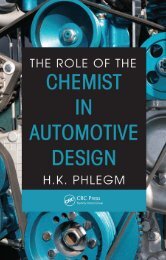Lightweight Electric/Hybrid Vehicle Design
Lightweight Electric/Hybrid Vehicle Design
Lightweight Electric/Hybrid Vehicle Design
Create successful ePaper yourself
Turn your PDF publications into a flip-book with our unique Google optimized e-Paper software.
112 <strong>Lightweight</strong> <strong>Electric</strong>/<strong>Hybrid</strong> <strong>Vehicle</strong> <strong>Design</strong><br />
The technology of solar cells, Fig. 5.5, has been given a recent boost by the Swiss Federal<br />
Institute of Technology who claim to have outperformed nature in the efficiency of conversion of<br />
sunlight to electricity even under diffuse light conditions. The cell has a rough surface of titanium<br />
dioxide semiconductor material and is 8% efficient in full sunlight rising to 12% in diffuse daylight.<br />
For more conventional cells, such as those making a Lucas solar panel, these are available in<br />
modules of five connected in series to give maximum output of 1.3 watts (0.6 A at 2.2 V). Some<br />
ten modules might be used in a solar panel giving 13 watts output in summer conditions. Power vs<br />
voltage and current vs voltage are shown at (a) for so-called ‘standard’ and ‘typical’ operating<br />
conditions. 100 mW/cm 2 solar intensity, 0° C cell temperature at sea level defines the standard<br />
conditions against 80 mW/cm 2 and 25°C which represent ‘typical’ conditions at which power<br />
output per cell drops to 1 W. Temperature coefficients for modules are 0.45% change in power<br />
output per 1° C rise in temperature, relative to 0° C; cell temperatures will be 20° C above ambient<br />
at 100 mW/cm 2 incident light intensity. Variation of solar energy at 52° north latitude, assuming a<br />
clear atmosphere, is shown at (b). On this basis the smallest one person car with a speed of 15 mph<br />
and a weight of 300 lb with driver would require 250 W or 50 ft 2 (4.65 m 2 ) of 5% efficient solar<br />
panel – falling to 12.5 ft 2 (1.18 m 2 ) with the latest technology cells. A 100 Wh sealed nickel–<br />
cadmium battery would be fitted to the vehicle for charging by the solar panel while parked.<br />
The future, of course, lies with the further development of advanced cell systems such as those<br />
by United Solar Systems in the USA. Their approach is to deposit six layers of amorphous silicon<br />
(two identical n-i-p cells) onto rolls of stainless steel sheet. The 4 ft 2 (0.37 m 2 ) panels are currently<br />
6.2% efficient and made up of layers over an aluminium/zinc oxide back reflector. The push to yet<br />
higher efficiencies comes from the layer cake construction of different band-gap energy cells,<br />
each cell absorbing a different part of the solar spectrum. Researchers recently obtained 10%<br />
efficiency in a 12 in 2 (0.09 m 2 ) module.<br />
Rapid thermal processing (RTP) techniques are said to be halving the time normally taken to<br />
produce silicon solar cells, while retaining an 18% energy conversion efficiency from sunlight.<br />
Researchers at Georgia Institute of Technology have demonstrated RTP processing involving a 3<br />
minute thermal diffusion, as against the current commercial process taking 3 hours. An EC study<br />
has also shown that mass production of solar cells could bring substantial benefits and that a £350<br />
million plant investment could produce enough panels to produce 500 MW annually and cut the<br />
generating cost from 64 p/kWh to 13p.<br />
E F<br />
Accel sensor<br />
Fig. 5.6 Overall system configuration.<br />
Remaining capacity<br />
<strong>Vehicle</strong><br />
control unit<br />
Battery power limit<br />
Motor Inverter Relay<br />
box<br />
Charger<br />
V<br />
Battery<br />
controller<br />
A<br />
Cell controller Cell controller<br />
modules (8 cells)<br />
T T<br />
battery pack (12 modules)<br />
signal line<br />
power line<br />
Cooling fan<br />
T: temp. sensor<br />
V: voltage sensor<br />
A: current sensor







